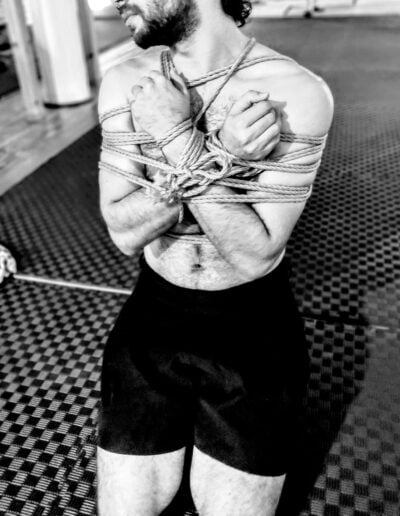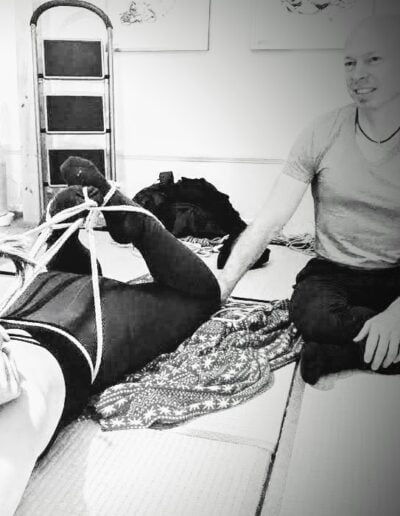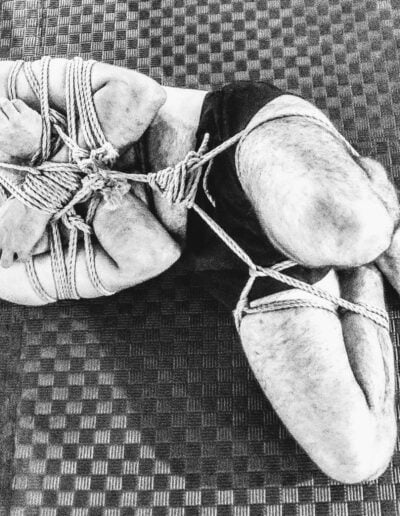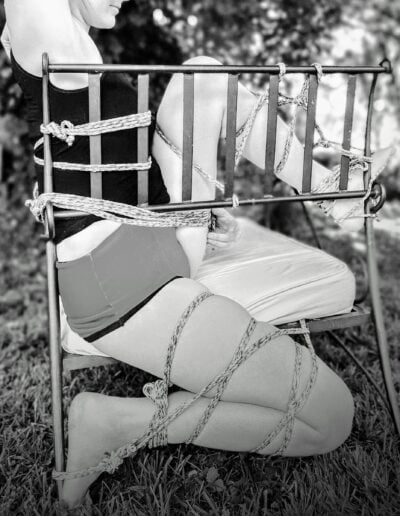Bound Bodywork

Bound Bodywork / Shibari Healing
A Shibari session is an intense journey for all genders into empowered surrender, creating an intense physical, psychological, emotional state of vulnerability that when faced, enables you to surrender into yourself & experience the truth that lies within.
A Shibari bodywork session involves working with ropes and meditative states to channel energy, feelings of surrender and connection with transcendental consciousness, free from the limitations of the body.
It can connect you with your inner warrior. With shibari bodywork, you may release emotional energetic blocks and outdated belief patterns. You can let go of fear, rage, anger, guilt, shame, and self-limiting judgements.


Somatic Experience
The meditative experience in Shibari is very unique to the individual. Often feelings of euphoria, groundedness, being hugged/held and our minds eye opening to the universe can arise when allowing ourselves to trust and surrender to an experience out of our human control. As human beings we all have a very hard time letting go. To sink deep into our physical bodies can facilitate a huge release and sense of relaxation.
As individuals we all experience daily stress and trauma in our lives. Unconscious painful infrastructures of our being, lives deeply in our bodies and sometimes it can come from places we aren’t even aware of. When we introduce our bodies to something new it will react in different ways sometimes ways we don’t expect. This can happen in ropes.
Shibari can be a great way to release stuck patterns. When we have a traumatic experience we view that experience with a sense of fear. We will often tense up and have a “fight or flight” reaction. Through rope practices, there may be a chance for you to re-write and create positive experiences with the experiences you have.
Many experince the release of stored fear, sadness, anxiety etc in a session. It is important to trust the person who is tying you completely, to sink deeply into this experience.
Dig Deeper
The Sacred Art of Shibari Healing
Shibari, a revolutionary healing modality originated in Japan from Hojo-jutsu, a method of restraining captives, before morphing again into the erotic bondage Kinbaku (Kinbaku-bi literally translates as “the beauty of tight binding”) in the late 19th and early 20th centuries.
Central to the art is creating patterns that contrast and complement the natural curves of the body. The beauty lies in juxtaposition: bare skin against rough rope, strength against exposure, a sense of calm against the knife-edge of risk.
It was soon discovered that some forms of Kinbaku style rope bondage and patterns have within the inherent power to heal. They can do so by opening the body energetically so it becomes more receptive to the naturally occurring connective and healing energy that flows through us all.
read more...
This energy when directed with specific intention, and the correct technique can heal the body, the mind and spirit, says Steven James, a Shibari Master, highly respected for his skills and with high regard for those who come into his ropes, and overall philosophy about the healing energy of connective style Kinbaku/Shibari.
“Remember the emphasis on the heart. The mind lives in doubt and the heart lives in trust. When you trust, suddenly you become centered.” ~ Osho
It is also believed that when consciously applied and directed, sacred Shibari can assist to heal relationships and wounded hearts by teaching to trust and to surrender again where before there was only mistrust and resistance.
Bodhi Zapha, an International Shibari Master describes Shibari Healing as an intense shamanic journey for all genders into empowered surrender and vulnerability for return to original innocence.
One focus is on healing the wounded Feminine within, allowing her to to feel safe to express her full range of emotions.To be witnessed by our inner Masculine Shiva consciousness to reunite these two poles of our being in harmony and appreciation of each other.
A Shibari healing experience described by Mila Kriletich, Writer & Meditation teacher

What is the cost of a session?
90 – 120 min CHF. 155.- (cash or twint)
Additional time or special requests can be accommodated for an additional fee.
If you have a low income, please feel free to contact me to discuss pricing options that may be more affordable for you.
Do I need any experience to be tied up?
No, you don’t need any previous experience to be tied up. However, as a beginner, it’s important to learn how your body feels in rope and to avoid starting with advanced ties that could be dangerous. I am happy to guide you through the process and provide instructions on how to safely enjoy rope bondage.
Who do you tie?
I provide shibari bodywork sessions for individuals of any gender and body type who are over the age of 18. If you have any medical conditions, please let me know and we can discuss whether rope bondage is safe and suitable for you.
Is shibari/rope bondage safe?
Shibari is considered to be “edge play” because it involves a level of risk that should be carefully managed and minimized. Even with all the precautions that I take, there is always a potential for risks, so it is important for you to be aware of them and to share in the responsibility for managing them. The key to minimizing risks is good communication, so please be open and honest with me about your experience, your comfort level, and any concerns that you may have. If you would like to learn more about the risks associated with rope bondage and how to manage them, I recommend the following resources:
– Shibari Study – General Rope Safety
– Clover Brooke – Rope Bottoming Guide
– Anatomie Studio – Nerve Damage
What should I wear?
You should wear whatever makes you feel comfortable and confident during your shibari bodywork session. Some people prefer to wear a dress, yoga outfit, underwear, depending on their personal preferences and the specific intentions for their session. I want you to feel comfortable and relaxed during our session, so please don’t hesitate to let me know if you have any questions or requests about what to wear.
How do I prepare?
Most important think about your intention for the session. Avoid having heavy food up to an hour before. Avoid using perfume or other strong smells.
I am not flexible or have an injury. Can you still tie me up?
Yes, definitely. A rope session can be tailored to suit any body type, including individuals who are not very flexible or who have injuries. We will discuss what techniques and positions will work best for your specific body during our session, and we will make any necessary adjustments to ensure your comfort and safety. You don’t need to be flexible or have a perfect body to enjoy rope bondage, so please don’t hesitate to contact me to schedule a session.
I have a medical condition. Can you still tie me?
If you have a medical condition, it is best for us to discuss it before planning a session, to ensure that it is safe and appropriate for you to be tied up. In some cases, I may ask you to consult with your healthcare provider to determine whether rope bondage is safe for you. For example, if you are taking anticoagulant medication, I will likely not provide rope bondage services for you, as this medication can increase the risk of bruises or bleeding.
What happens in a typical first session?
First third: sharing tea and talking about the intention of the session – focus is on your background, physical and emotional limits and need.
Middle third: being tied based on the intention of the session – with one or more rope, on the soft floor.
Final third: aftercare/grounding in the body and mind – can be in meditation, resting alone or in physical contact, drinking more tea or talking about the experience.
What are some common intentions for shibari bodywork sessions?
There are many different intentions that people may have when engaging in a rope session. Some common intentions include creating a sensual, relaxing, playful, challenging, or transformative experience. The specific intention or intentions that you have for your shibari bodywork session will depend on your personal preferences and goals, and we can discuss them in more detail during our consultation. I am here to support you in achieving your desired outcome, so please don’t hesitate to share your intentions with me and we can work together to make your session as fulfilling and enjoyable as possible.
What is the intention of the session?
It can be many many things, here is a list of examples.
Learning to trust and surrender in a intimate and vulnerable situation
Discharging trauma
Letting go of control and being cared for
Facing fears of losing mobility and being constricted
Exploring a shadow or fantasy
A deep meditation
Facing intense sensations physical and emotionally
Working with a specific body part like hands or throat
Where do you host the session?
Shibari bodywork sessions are typically hosted in Schaffhausen, Webergasse, a few minute walk from the train station. Other locations or your home can be negotiated.
Is it psychotherapy?
No – not in the traditional sense. It could be described as a somatic exposure therapy which is common when treating post traumatic stress disorder.
Is it sexual?
Sometimes but usually no. It is sensual, loving and goes much deeper than “just sex”. Developing a healthy relationship to power and surrender in life in general helps in the relationship to sexuality too.
Is it feminism?
Yes, being temporally and consensually bound is greatly empowering. So is taking ownership ones own sexual expression. Trusting, letting go of control and showing vulnerability are acts of strength. Independent of gender.
Is it BDSM?
Yes and no. Bondage is B in BDSM. But BDSM is usually not practiced for therapeutic reasons.
Is it painful?
Depends on the intention. The intensity can be anything from soft to extreme. Most importantly the amount of pain is decided by the client.
Is it tantric?
Yes – as in using consciousness, polarity, breath and intention. Many clients describe it as working with energy blockages, dearmoring and kundalini awakening.
Is it shamanic?
Yes – as in the strong focus on ritual and guidance. A big inspiration has been Peter A. Levine’s book Waking the Tiger: Healing Trauma.
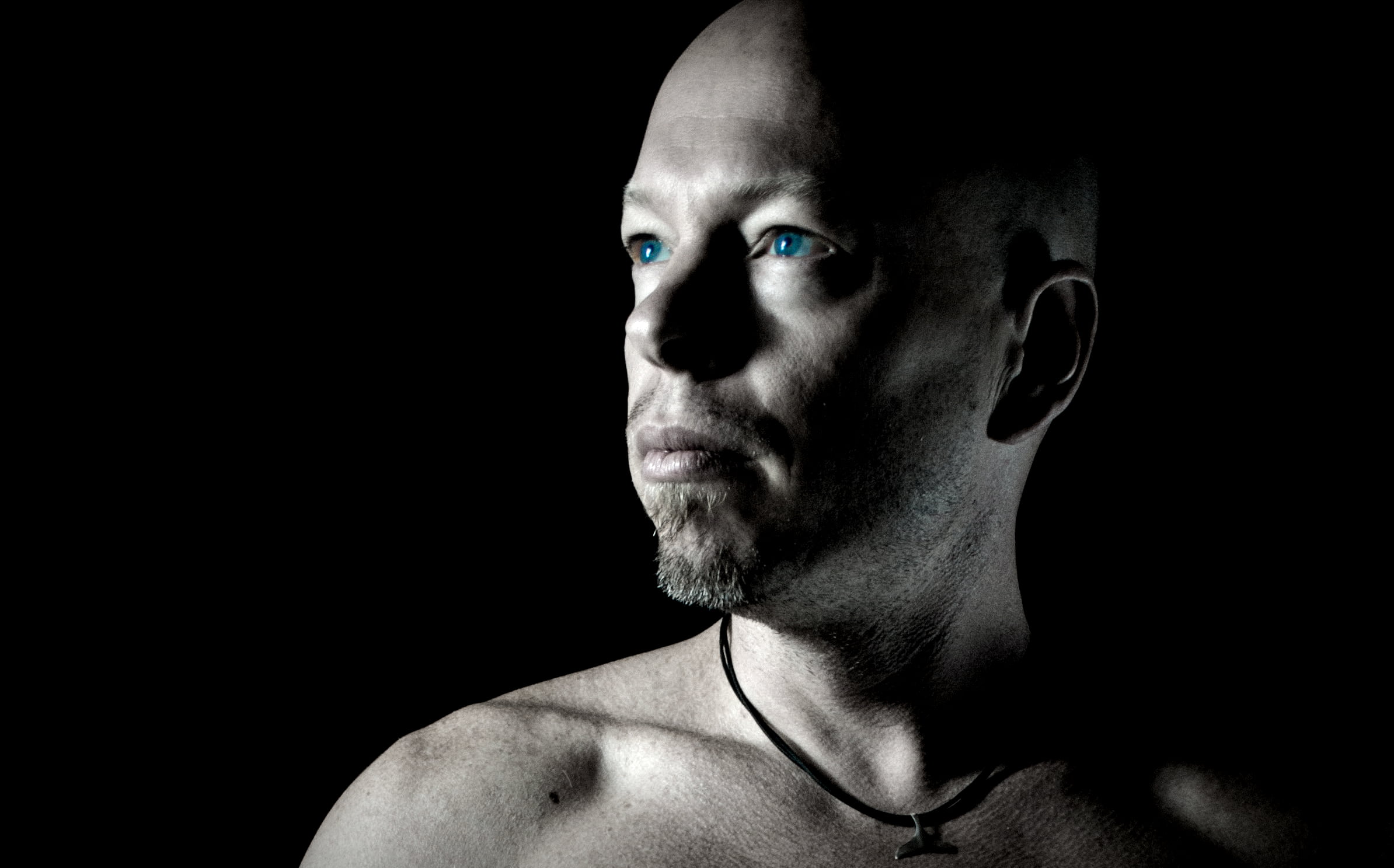
Shibari experiences
Webergasse, Schaffhausen
David
We are free to be bound and bound to be free!

